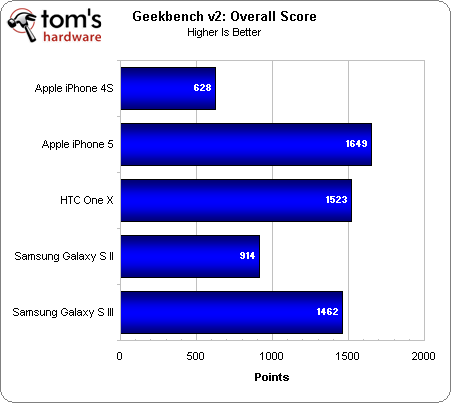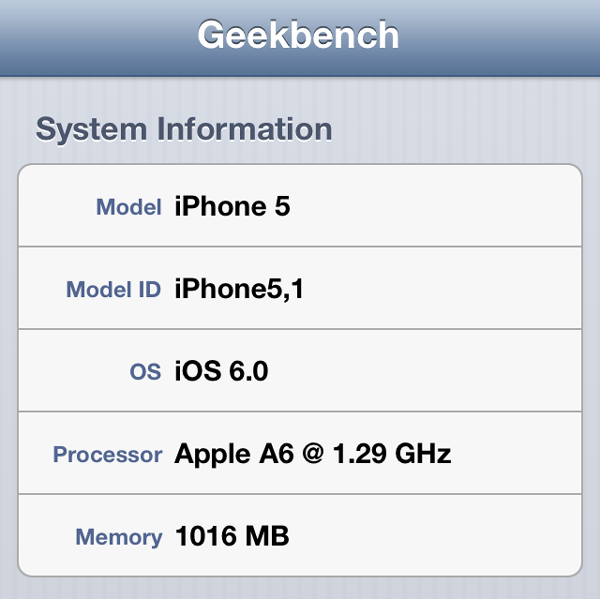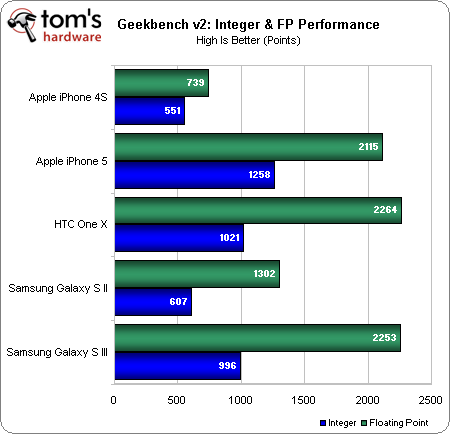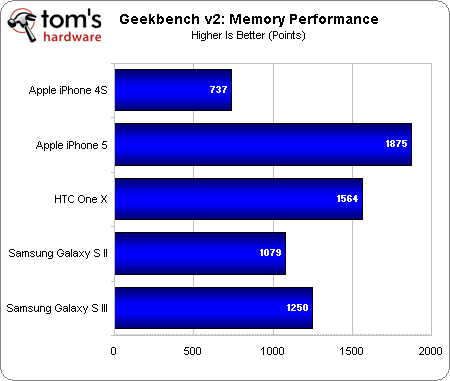Apple iPhone 5 Review: CPU, GPU, Battery, Wi-Fi, And Display Testing
Apple's A6-powered iPhone 5 gets the Tom's Hardware treatment as we benchmark its twin processing cores, its triple-core graphics engine, and its more vibrant display. Battery life testing and Wi-Fi performance measurements round out our analysis.
A6 Processor Performance: The 400 FPS Camera Tells All
It's hard to compare the raw processing performance of each SoC's architecture, since each one runs at a different frequency. The A5X found in Apple's iPhone 4S and third-gen iPad operated at 1 GHz, while the iPhone 5's A6 is clocked at 1.3 GHz (at least according to Geekbench 2.3.6). Initial reports claimed the A6 was a 1 GHz part, but that appears to be inaccurate.
In terms of raw performance, the iPhone 5's A6 posts benchmark results close to 2.5x faster than the A5X (iPhone 4S). Apple's newest smartphone-oriented SoC is even able to stay competitive with the 1.5 GHz MSM8960 featured in HTC’s One X and Samsung's Galaxy S III.
The sub-tests suggest that Apple trails Qualcomm's custom design when it comes to floating-point performance, though, as we discussed in Snapdragon S4 Pro: Krait And Adreno 320, Benchmarked, mobile developers tend to focus their code more on integer math due to the limitations of today’s SoCs.
Apple enjoys a lead in memory performance, its 1 GB of LPDDR2-1066 easily delivering a lot more bandwidth than the iPhone 4S' 512 MB of on-package LPDDR2-800.
Alone, of course, those numbers mean very little. But in the video below, we see the iPhone 4S, iPhone 5, and One X opening and rendering the mobile CNN website using a 400 FPS high-speed camera. Every 14 seconds of video is roughly one second in the real world. We're simply magnifying the difference between each phone to illustrate the implications of hardware specs on what you'll see using the devices.
There are some variables in play here. The Web browsers, to begin. Also, you have networking performance to consider. And of course there are the SoCs themselves. But the experience is what matters most to us, and using the iPhone 5 is clearly a snappier experience than the iPhone 4S before it, even if you leave competition out of the comparison.
Get Tom's Hardware's best news and in-depth reviews, straight to your inbox.
Current page: A6 Processor Performance: The 400 FPS Camera Tells All
Prev Page The Lightning Connector Next Page PowerVR SGXMP3: Crazy Fast, But Underutilized Today-
g-unit1111 Why can't everyone - Apple included - agree on a standardized power adapter like mini USB?? It would make not only our lives easier but the manufacturers who make these accessories able to have one device and on cord that works with everything.Reply -
mayankleoboy1 The LCD tests puzzle me a little. Most other reviews said that the SGS3 has a poorer display and the iphone5 has a better display , with much better contrast ratio and sRGB compliance.Reply
Maybe i am reading it wrong ? -
reprotected There needs to be more explanation in the quality of the screens. We all know Galaxy SIII covers a larger colour gamut, but does it beat the iPhone 5 in terms of accuracy is one big thing we want to know based on your eyes, not numbers and graphs.Reply -
kensingtron Great article ^_^Reply
Second to last paragraph:
"For example, Samsung's Galaxy S III has been on the market for a while, and its LCD is a market leader"
LCD = AMOLED -
acku kensingtronGreat article ^_^Second to last paragraph:"For example, Samsung's Galaxy S III has been on the market for a while, and its LCD is a market leader"LCD = AMOLEDReply
My apologies. On page 6 we mentioned that S3 uses AMOLED. I'll make a correction. Thanks for the shout out. -
dragonsqrrl Excellent article as usual, very comprehensive. Hopefully this helps to dispel some of the performance myths about the iPhone that seem to circulate here on Tom's.Reply -
acku mayankleoboy1The LCD tests puzzle me a little. Most other reviews said that the SGS3 has a poorer display and the iphone5 has a better display , with much better contrast ratio and sRGB compliance.Maybe i am reading it wrong ?Reply
http://news.cnet.com/8301-13579_3-57524291-37/color-me-prettier-galaxy-s3-display-outdoes-iphone-5s/ Check that one out. :)
I'd still like to add an accuracy test at some point. I need to think about how to approach that problem. The way people normally talk about color accuracy (besides deltae and gamma) are sometimes too abstract with color terms that professionals use. I'd like to find a way to present the information in a more intuitive manner. -
ojas g-unit1111Why can't everyone - Apple included - agree on a standardized power adapter like mini USB?? It would make not only our lives easier but the manufacturers who make these accessories able to have one device and on cord that works with everything.Agreed...though don't most smartphones today use the microUSB B-type connector?Reply -
dare2blink Seems apple has not inovated for a couple of years now. I´m shocked that the most inovative and arguably the best phone of the year is not even mentioned in this article. Nokia Lumia 920 is definitely the most inovative na the most complete phone reseased so far. It has much better build quality, a better screen and camera than the iphone 5, not to mention a much more inovative OS.Reply



